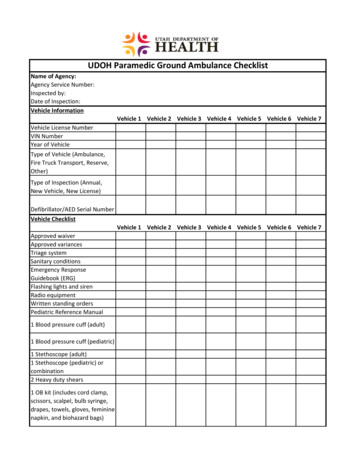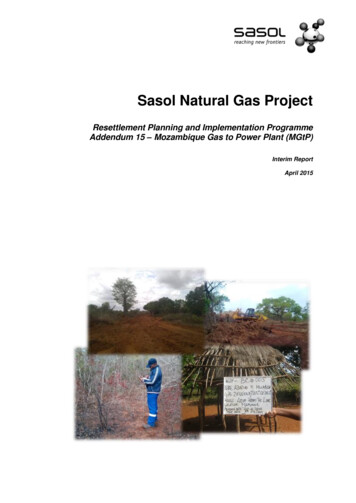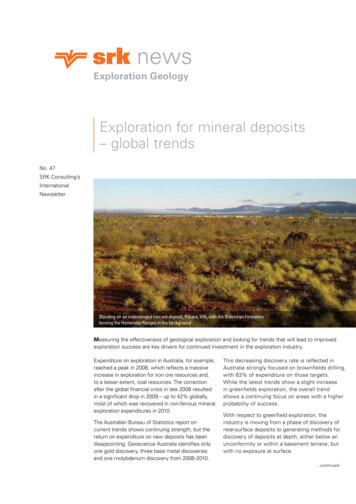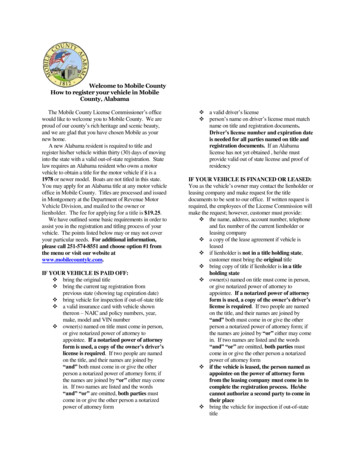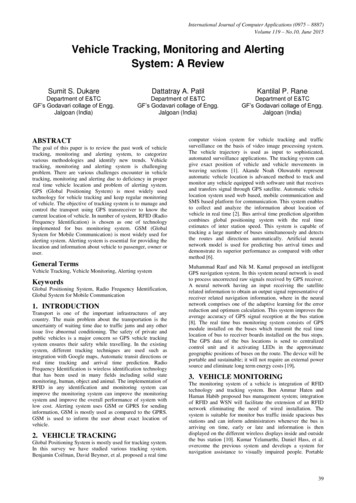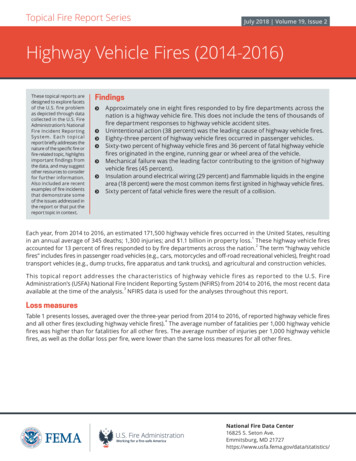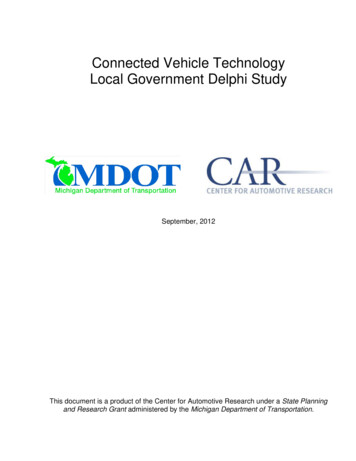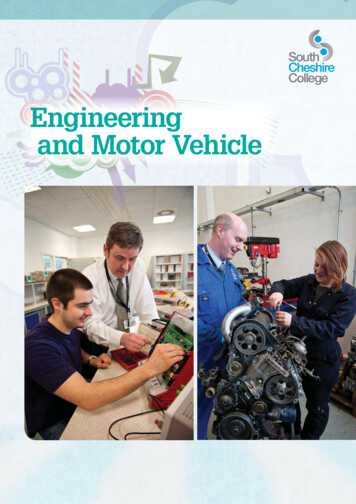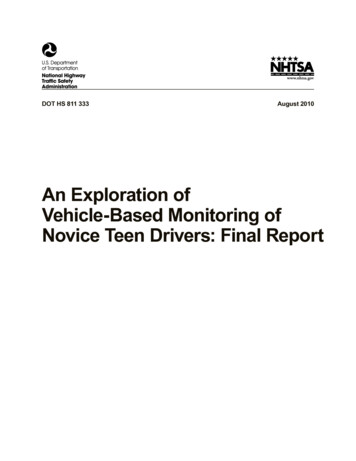
Transcription
DOT HS 811 333August 2010An Exploration ofVehicle-Based Monitoring ofNovice Teen Drivers: Final Report
DISCLAIMERThis publication is distributed by the U.S. Department of Transportation, National HighwayTraffic Safety Administration, in the interest of information exchange. The opinions, findings,and conclusions expressed in this publication are those of the authors and not necessarily thoseof the Department of Transportation or the National Highway Traffic Safety Administration.The United States Government assumes no liability for its contents or use thereof. If trade names,manufacturers’ names, or specific products are mentioned, it is because they are considered essentialto the object of the publication and should not be construed as an endorsement. The United StatesGovernment does not endorse products or manufacturers.
1. Report No.2. Government Accession No.3. Recipient’s Catalog No.DOT HS 811 3334. Title and Subtitle5. Report DateAn Exploration of Vehicle-Based Monitoringof Novice Teen Drivers: Final ReportAugust 20106. Performing Organization Code8. Performing Organization Report No.7. Author(s)Neil Lerner, James Jenness, Jeremiah Singer, Sheila Klauer,Suzanne Lee, Max Donath, Michael Manser, & Nicholas Ward10. Work Unit No. (TRAIS)n code9. Performing Organization Name and AddressWestat1600 Research Blvd.Rockville, MD 2085011. Contract or Grant No.DTNH22-05-D-0100212. Sponsoring Agency Name and Address13. Type of Report and Period CoveredNational Highway Traffic Safety Administration1200 New Jersey Avenue SE.Washington, DC 20590Draft Final Report14. Sponsoring Agency Code15. Supplementary NotesNHTSA Task Order Manager: Stephanie Binder16. AbstractThe purpose of the National Highway Traffic Safety Administration project titled “An Exploration of Vehicle-BasedMonitoring of Novice Teenage Drivers” was to systematically identify and structure the range of alternatives thatmight use vehicle-based sensing to mitigate the novice teen driver safety problem. The project sought to identify arange of promising approaches, ascertain user needs and preferences, indicate the research required to evaluate andcompare alternatives, and provide recommendations for carrying this work forward. This report describes the activitiesand findings of the project. A series of literature searches was conducted to identify key research and reports related toteen driver behavior and monitoring devices. Focus groups of teen drivers and their parents were conducted to exploreissues of motivation, preference, and usability of teen monitoring systems and concepts. A workshop on in-vehiclemonitoring of novice teen drivers was held to share the project’s initial findings and ideas with a diverse group ofoutside experts and stakeholders, and collaborate to identify opportunities and needed steps to take full advantage ofdriver monitoring capabilities. A research study was conducted to collect new data on teen driving under naturalisticconditions. Researchers instrumented the personal vehicles driven by novice teen drivers and recorded extensive detailon their behavior in the course of naturally occurring travel. Results suggest that teens classified as high risk based onearly driving behaviors and crash records engaged in secondary tasks, high risk secondary tasks, and speedingbehaviors significantly more frequently than did the low risk drivers. Results also suggested that the high risk teensperformed extreme levels of longitudinal deceleration during “normal,” baseline driving significantly more frequentlythan did the low risk drivers. Based on the findings of these tasks, a set of high priority research needs was developed,and a research plan was devised to propose research to address these needs.17. Key Words18. Distribution StatementNovice Driver, Vehicle Adaptation,Driver Monitoring, Safety19. Security Classif. (of this report)UnclassifiedDocument is available to the public from theNational Technical Information Servicewww.ntis.gov20. Security Classif. (of this page)21. No of PagesUnclassified215Technical Report Documentation PageForm DOT F1700.7 (8-72)Reproduction of completed page authorizedi22. Price
AcknowledgementsThe authors thank Stephanie Binder, the NHTSA Task Order Manager, and Michael Perel formany contributions throughout the project.In addition to the report authors, key contributors to the project include: Elisha Lubar, DianeSnow, David Kidd, and Candice Wallace (Westat); Tom Dingus, Jon Hankey, and ShaneMcLaughlin (Virginia Tech Transportation Institute); and Rich Hoglund (University ofMinnesota).Finally, we thank all of the participants in the workshop, who contributed their expert knowledgeand insights.ii
Executive SummaryNovice teen drivers have exceptionally high rates of crash involvement. Despite efforts in drivertraining, graduated licensing, enforcement, and safety education, novice teen drivers still haveper-mile crash rates several times higher than mature drivers. Recent advances in technologynow make feasible another means of addressing this problem – the use of in-vehicle technologyto sense and respond to driver behavior. Sensing and communications technology permit realtime feedback to drivers, alerts to parents, summary reports on performance, coaching to correctdriving errors, real time vehicle adaptation to current conditions, and the integration of driveractions into programs that provide positive or negative consequences.Since these technologies have only recently become feasible for consumer use, there is littleresearch or real-world experience that suggests how effective they are or what features are mosteffective. Some of the earliest implementations of driver monitoring devices were in vehiclefleets, where fuel efficiency and vehicle location tracking were often the primary purposes ofmonitoring. Fleet monitoring devices, however, have been used to monitor behaviors that aredirect or indirect measures of safety, and studies have shown dramatic improvements in a rangeof safety-relevant behaviors.There are now a number of ongoing studies to evaluate driver monitoring strategies for teendrivers. Although there have been few published reports with rigorous experimental designs andanalyses, it appears that monitoring can significantly reduce the occurrence of risky behaviors,especially among the most risk-prone teens. While initial findings show promise, there iscurrently little evidence to help guide the development and implementation of teen drivermonitoring systems and programs. Furthermore, there has been little advantage taken of vehicleadaptation possibilities. Teen monitoring is a complex application that requires carefulconsideration of required functions, technologies, interfaces, implementation strategies, andstakeholder concerns.This report summarizes the findings of a project titled “An Exploration of Vehicle-BasedMonitoring of Novice Teenage Drivers,” which was initiated by NHTSA to assess the state ofthe art and the state of practice in teen driver monitoring. Furthermore, a series of new researchprojects were conducted to provide data on the effects of monitoring on teen drivers, assessteens’ and parents’ opinions and preferences for monitoring, and assemble an expert workshopon teen driver monitoring to establish priorities for future efforts in the field. Finally, based onthe results of these tasks, a research plan was created to address high priority research required toadvance the field of teen driver monitoring, culminating in a major field evaluation ofmonitoring systems.The project began with a thorough literature review to identify key research, reports, andstatistics related to teen driver behavior and monitoring devices. This provided importantbackground on teen behaviors, characteristics, and situations that are associated with risk, andtherefore important to consider in a monitoring system. The initial stage of the project alsoincluded a review of current and emerging technologies that could be used in monitoringsystems.In parallel with the information search and analytic activities of this project, a research study wasconducted to collect new data on teen driving under naturalistic conditions. The study wassponsored by the National Institute for Child Health and Human Development with additionaliii
funding from NHTSA. The purpose of the study was to fill in the research gaps in teen drivingresearch related to 1) assessing the prevalence of teen driver engagement in risky drivingbehaviors and 2) understanding which behaviors are associated with an increase in a teen driver’scrash/near-crash risk. Researchers instrumented the personal vehicles driven by 42 novice teendrivers and unobtrusively recorded extensive detail on their behavior in the course of naturallyoccurring travel over 18 months. Participants were grouped into high risk and low risk groupsbased upon their involvement in crashes and near-crashes during the first six months of driving.A crash was operationally defined as any physical contact with an object where kinetic energy ismeasurably transferred. A near-crash was operationally defined as any circumstance thatrequired a rapid, evasive maneuver by the subject vehicle or other vehicle, to avoid a crash.Results suggested that the high risk teen drivers engaged in secondary tasks, high risk secondarytasks, and speeding behaviors significantly more frequently than did the low risk drivers. Resultsalso suggested that the high risk teens performed extreme levels of longitudinal decelerationduring “normal,” baseline driving significantly more frequently than did the low risk drivers. It isnot evident to what extent the relationship of these behaviors to the driver risk categories is acausal one. That is, are the “high risk” drivers at greater risk because they engage in thesebehaviors or are the behaviors merely correlates that suggest who the at-risk drivers might be? Ineither case, the finding may be useful for the design of teen monitoring systems. To the extentthat the relationship is causal, effective feedback to teen drivers may decrease the prevalence ofthese behaviors, so their involvement in crashes may also be reduced. To the extent that thebehaviors identify at-risk teen drivers, the information could be used to adapt warning andfeedback algorithms to adjust for the greater risk.A series of focus groups were conducted with teens and parents to explore issues of motivation,preference, and usability of alternatives. Three focus groups were conducted with teens and threewere conducted with parents. All groups followed a similar discussion path that addressed therole of parents in controlling teens’ driving, reactions to in-vehicle technology options andfeeling about monitoring, and preferences among hypothetical monitoring systems and programs.The project also included a workshop that brought together experts in a wide variety ofprofessional fields related to teen safety and monitoring. The workshop objective was to sharethe project’s initial findings and ideas with a diverse group of outside experts and collaborate toidentify best opportunities and needed steps to take full advantage of driver monitoringcapabilities. The workshop emphasized the functional monitoring needs and programmaticstrategies rather than focusing on the sensor and communications technologies themselves. Theintent was to provide insights on promising approaches and strategies, issues related tosuccessful implementation, short-term and long-term research needs, and suggested next steps.Finally, based on the results of the other tasks in this project, a set of high priority research needsand a recommended research plan were devised. Forty-two research needs were identified, andwere organized under three major topic areas: evaluating systems and programs, system design,and use and acceptance. The research plan, which was designed to address the research needs,includes six component studies. Four of these are areas of fundamental research that will informany program of teen driver monitoring. Another component of the recommended researchapproach is to foster the coordination and integration of research activities and findings bydiverse entities. A final component of the proposed plan is a large scale field evaluation of theactual benefit of novice teen driver monitoring.iv
Table of Contents11.11.21.3Introduction . 1Novice teen driver crash problem and driver monitoring technology . 1Project objectives. 4Organization of this report. .4.12.4.22.4.32.4.42.4.52.5Information search for novice teen driver monitoring system requirements . 6Overview of search activities . 6Behaviors, situations, and characteristics to monitor . 6Enabling technologies . 8Measurement technology and sensors (including interlocks) . 9Communication technology . 11Interlocks and limiters. 11Driver feedback technology . 12Driver identification technology . 13Current system functions . 14Enabling technologies status . 16Implementation strategies . 18Driver feedback . 19Vehicle adaptation . 19Reporting. 20Coaching . 20External motivation . 21Summary of information search . 213Teen and parent focus groups . 223.1Summary of key findings . 223.1.1 Parents’ concerns . 223.1.2 Best and worst things about teenagers being able to drive independently . 223.1.3 Regarding parental concerns and control . 233.1.4 In-vehicle technology. 253.1.5 Four hypothetical monitoring systems and features . 273.1.6 Use of in-vehicle monitoring device in various programs . 303.1.7 Interest in utilizing an in-vehicle monitoring device . shop on novice teen driver monitoring . 32Workshop activities . 32Summary of presentations . 33Breakout group procedure . 34Breakout group reports . 36Driver feedback breakout group report . 36Reporting breakout group report . 38Vehicle adaptation breakout group report. 40Coaching breakout group report . 41External motivation breakout group report . 42Additional discussion points. 45Conclusion . 46v
5Findings from teen naturalistic driving study . 475.1Method . 475.1.1 Participants . 475.1.2 Apparatus . 485.1.3 Data reduction . 495.2Results . 505.3General conclusions. 566Research plan . 576.1Approach to defining research goals . 576.2General set of research needs . 586.3Research plan. 606.3.1 Research study: Contributions of basic aspects of monitoring systems . 616.3.2 Research study: Applications of vehicle adaptation . 636.3.3 Research study: Driver behaviors for monitoring/feedback and for safety benefitevaluation . 656.3.4 Research study: Design for family use of monitoring systems. 686.3.5 Research study: Coordination and integration of research activities . 696.3.6 Research study: Large scale field evaluation . 717Summary . 778References . 78Appendix A: Novice teen research findings . 81Appendix A1: Novice driver research findings: Teen behaviors. 82Appendix A2: Novice driver research findings: Driving situations . 92Appendix A3: Novice driver research findings: Problem driver characteristics . 98Appendix A4: Novice driver behavior references . 100Appendix B: Parent focus group discussion path . 108Appendix C: Workshop participants. 110Appendix D: Workshop presentations . 112Appendix E: An exploration of vehicle-based monitoring of novice teenage drivers:Draft final report . 147vi
List of FiguresFigure 1. The quad-image of the 4 continuous video camera locations. From upper left to right:driver face camera, forward view, over-the-shoulder, and rear-view . 48Figure 2. The quad image with two continuous cameras on the top two locations with the stillframes in the two bottom locations. From upper left to right: driver face view, forward view,the blurred image of the vehicle cabin, and the back seat passenger lap camera . 49Figure 3. Percentage of trips taken by unbelted teen and adult drivers and teen passenger seat beltuse over 18 months of data collection. 51Figure 4. Percentage of teen driver trips where the high- versus low-risk drivers were engagingin high to moderate-risk secondary tasks (those that have previously been shown toincrease crash/near-crash risk) . 52Figure 5. The percentage of teen drivers from each risk group who performed maximumdecelerations for each deceleration level . 53Figure 6. Percentage of valid triggers for each trigger type . 55Figure 7. The percent of valid to invalid triggers for each trigger type . 55List of TablesTable 1. Status of enabling technologies . 16Table 2. Research issues . 58vii
1 IntroductionThis report presents the methods, findings, and recommendations of the National HighwayTraffic Safety Administration project titled “An Exploration of Vehicle-Based Monitoring ofNovice Teenage Drivers.” The project involved a combination of information search, analyticactivity, new research, and expert/stakeholder input in order to identify issues, options, andresearch needs for advancing the development, use, and evaluation of teen driver monitoringtechnologies. As used in this report, the term “driver monitoring” refers not only to the detectionand recording of driving behaviors, but also encompasses the way in which data are provided tousers (e.g., real-time feedback to drivers, reports of driving performance to parents, and so forth).1.1 Novice teen driver crash problem and driver monitoringtechnologyInexperienced teen drivers have exceptionally high rates of crash involvement. In 2006, 5,658young drivers between the ages of 16 and 20 were killed in traffic crashes, and an additional410,000 were injured (NHTSA, 2007). Teen drivers in general have much higher per-mile crashrates than more mature drivers. For example, Kweon and Kockelman (2003) found that driversunder the age of 20 have a crash rate about 3.5 times the rate of mature drivers. But thisenhanced risk for teenage drivers in general is small relative to the risk for those least mature andleast experienced teen drivers. Crash rates are highest at age 16. Per-mile crash rates (for crashesof all types) for 16 year olds are about double those of 18-19 year olds. While the difference isnot as extreme for fatal crashes, 16 and 17 year old drivers also have the highest crash rates forthese most severe crashes (Insurance Institute for Highway Safety, n.d.). Under some drivingconditions, this already extreme crash rate becomes even greater, such as when there are multipleteen passengers or during night driving.Driver training, graduated licensing, enforcement, and safety education all have been directed atthe effort to reduce novice teen driver crashes. While safety benefits have been demonstrated, inparticular for graduated licensing, the benefits have yet been modest. Another approach, onlyexplored in recent years, is to use in-vehicle technology to sense and respond to teen driverbehavior. If key behaviors can be sensed, technology provides the opportunity for real timefeedback to the driver, alerts to parents, summary reports of incidents, evaluations ofperformance, coaching to correct errors, or provision of rewards or sanctions. There are manyoptions in terms of sensing technologies, behaviors and situations to monitor, communicationsstrategies, information to convey, and program implementation. The effectiveness, practicality,parental and public acceptance, and social desirability of various approaches are not wellunderstood, but some recent research studies show that monitoring technologies have thepotential to be effective tools to improve driver safety.Driver monitoring, feedback, vehicle adaptation, and reporting have been used effectively forsome time in various sorts of fleet management. Controlled studies have established that drivermonitoring can improve a range of safety-related behaviors in mature driver populations. Onestriking example comes from a study of an ambulance fleet in metropolitan Little Rock,Arkansas, where there were concerns regarding the ambulance fleet safety experience and driverperformance (Levick & Swanson, 2005). Data were collected over 18 months from 26ambulances equipped with monitoring and feedback devices. More than 250 drivers used the1
vehicles during the study period. The system monitored speed, acceleration, braking, corneringvelocity, seat belt use, turn signal use, lights and siren use, use of parking brake, and use ofbackup spotters. The system provided warnings when drivers approached predeterminedviolation levels and then alerted drivers when a violation was recorded. There were rapid,dramatic, and sustained drops in a variety of undesirable behaviors after implementation of thesystem. Compared to baseline performance, driver “penalty count” rates (instances of speeding,hard acceleration or deceleration, etc.) dropped from 0.018 miles per violation to 15.8 miles perviolation, seat belt violations dropped from 13,500 to 4, and vehicle maintenance costs werereduced by 20 percent.Another study investigated the effects of monitoring and feedback on 103 drivers from the fleetsof six different organizations in Israel that provided vehicles to their employees as part of theirbenefits program (Musicant, Lotan, & Toledo, 2007). An in-vehicle data recording system wasinstalled to provide driving feedback to drivers concerning episodes of hard braking, swerving,high vehicle speed, and GPS location data. Drivers could receive feedback through text messagesand on a dashboard display that used colored lights to indicate driving performance (green ismoderate, yellow is intermediate, red is aggressive). Drivers were also provided with monthlyreports that indicated their overall performance for each drive, as well as detailed feedback aboutparticular types of vehicle maneuvers, comparisons with performance in previous months, andcomparisons with other fleet drivers. From these data, risk indices were calculated based uponprevious crash records as well as the driving parameters collected by the system (e.g., trip time,vehicle location, number of hard braking maneuvers, etc.). After baseline data were collected fora period of eight weeks, feedback regarding braking patterns, speed selection, accelerationaround corners, and other unsafe driving maneuvers was stored on a website that the driverscould access. Results indicated a 38 percent reduction in crashes per 1,000 miles traveled withinthe first two months of receiving feedback. No recurring increase in crash rate was reportedthrough the first seven months of driving with feedback, thus indicating that the reduction incrash risk remained stable over time. In another study using the same system, Toledo, Musicant,and Lotan (2008) examined a different group of 191 drivers. The results showed a significantreduction of 38 percent in overall crash rates, but not in at-fault crash rates. However, theremainder of the fleet (which was neither monitored nor exposed to feedback) showed a 19percent reduction from the period before exposure to feedback to the period after exposure.There was also a significant correlation between crash rate and the calculated risk index for themonitored drivers. Fleet studies such as these show that driver monitoring and reporting systemscan have dramatic effects in improving safety-related behaviors.Another technology widely use
teen driver behavior and monitoring devices. Focus groups of teen drivers and their parents were conducted to explore issues of motivation, preference, and usability of teen monitoring systems and concepts. A workshop on in-vehicle monitoring of novice teen drivers was held to share the project's initial findings and ideas with a diverse group of
